
Montane grasslands and shrublands is a biome defined by the World Wildlife Fund. The biome includes high elevation grasslands and shrublands around the world. The term "montane" in the name of the biome refers to "high elevation", rather than the ecological term which denotes the region below treeline.
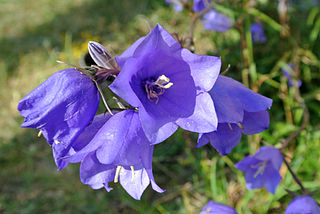
Campanula is the type genus of the Campanulaceae family of flowering plants. Campanula are commonly known as bellflowers and take both their common and scientific names from the bell-shaped flowers — campanula is Latin for "little bell".

Wahlenbergia gloriosa, commonly known as royal bluebell is a perennial herb in the bluebell family Campanulaceae. It has egg-shaped leaves near the base of its stem, linear leaves higher up and usually a single purple flower with a tube-shaped base. The flower is the floral emblem of the Australian Capital Territory.
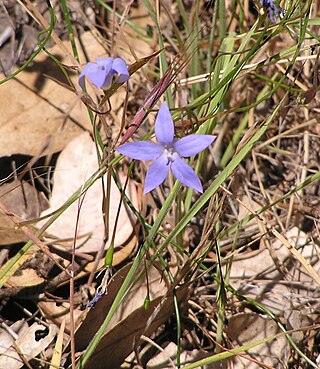
Wahlenbergia stricta, the Australian bluebell, tall bluebell or austral bluebell, is an Australian wildflower from the Campanulaceae family. It is considered the most commonly encountered of the Wahlenbergias. It is found in all Australian states but not the Northern Territory. It is often seen growing by the side of the road, enjoying the extra runoff.
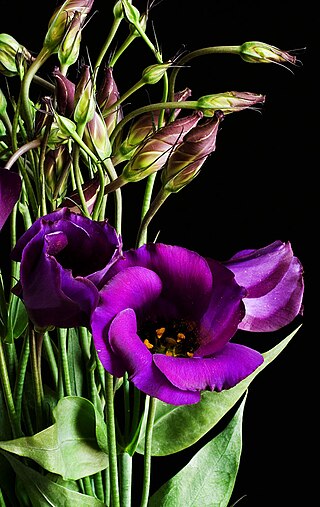
Eustoma russellianum is a species of flowering plant in the gentian family. One of its previous binomial names was Eustoma grandiflorum. Common names include showy prairie gentian, prairie gentian, Texas bluebells, Texas bluebell, bluebell, and Lisianthus.

Wahlenbergia gracilis, common name Australian bluebell, is an Asian wildflower from the family Campanulaceae. It also grows on western Pacific Ocean islands.

Hygrocybe chlorophana is a species of agaric in the family Hygrophoraceae. It has been given the recommended English name of golden waxcap in the UK. The species has a largely north temperate distribution, occurring in grassland in Europe and in woodland in North America and northern Asia; it has also been reported from mountainous areas of southern Australia. It typically produces basidiocarps in the autumn. In a few European countries, H. chlorophana is of conservation concern, appearing on national red lists of threatened fungi.

Eucalyptus ceracea also known as the Seppelt Range gum or Seppelt Range yellow-jacket, is a species of small tree or mallee that is endemic to a small area in the north of Western Australia. It has thick, fibrous or flaky bark on the trunk and larger branches, dull, glaucous, egg-shaped leaves arranged in opposite pairs, flower buds in groups of seven or nine, bright orange flowers and urn-shaped fruit. The leaves, buds and fruit are covered with a white wax.

Wahlenbergia capillaris, commonly known as tufted bluebell, is a plant in the family Campanulaceae and is native to Australia and New Guinea. It is an erect perennial herb with a few to many stems and grows to a height of 50 cm (20 in). The leaves are mostly linear with a few scattered teeth on the sides and the flowers are blue, bell-shaped with five lobes and arranged in cymes. This bluebell is widespread and common, occurring in all Australian mainland states and territories.

Wahlenbergia gracilenta, commonly known as annual bluebell, is a small herbaceous plant in the family Campanulaceae native to Western Australia.

Wahlenbergia fluminalis, commonly known as the river bluebell, is a small herbaceous plant in the family Campanulaceae native to eastern Australia.
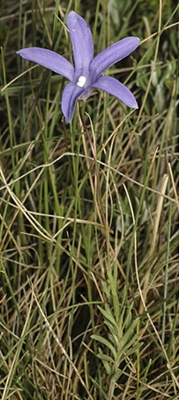
Wahlenbergia densifolia, commonly known as the fairy bluebell, is a small herbaceous plant in the family Campanulaceae native to eastern Australia.
Wahlenbergia graniticola, commonly known as the granite bluebell, is a herbaceous plant in the family Campanulaceae native to eastern Australia.
Wahlenbergia planiflora, commonly known as flat bluebell, is a small herbaceous plant in the family Campanulaceae native to eastern Australia.

Wahlenbergia saxicola, commonly known as the rock bluebell, is a herbaceous plant in the family Campanulaceae native to Tasmania in Australia.

Mertensia lanceolata, known as prairie bluebells, narrow-leaved languid lady, lance-leaved bluebells, and lance-leaved lungwort is a species of flowering plant native to western North America. A herbaceous perennial it has blue-green leaves alternately arranged on its smooth flowering stalk. Its flower buds are pink-purple and become more blue as they open. Accepted varieties include:

Wahlenbergia capensis, commonly known as the Cape bluebell, is a plant in the family Campanulaceae and is native to the Cape Province but has been introduced to Australia. It is an annual herb with up to four greenish blue, bell-shaped flowers with spreading petal lobes.
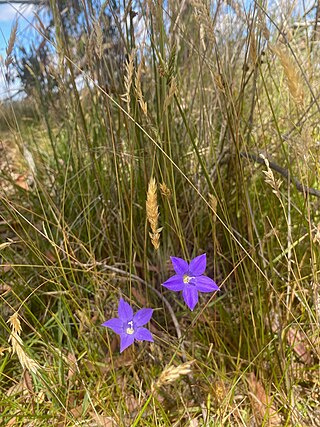
Wahlenbergia gymnoclada, commonly known as the naked bluebell, is a species of plant of the family Campanulaceae and is native to Australia. It is one of 200 species, in the Wahlenbergia genus. Of these species, 26 occur in Australia, including one introduced, and Tasmania has seven species of native Wahlenbergia. Species in this genus are “all slender perennial herbs and most species occur in grassy vegetation, although one occurs in rocky alpine areas. “The slender pedicels with delicate blue, symmetrical, flowers make this a relatively distinctive genus. The corolla tube is bell shaped, often with more or less spreading lobes”.
















